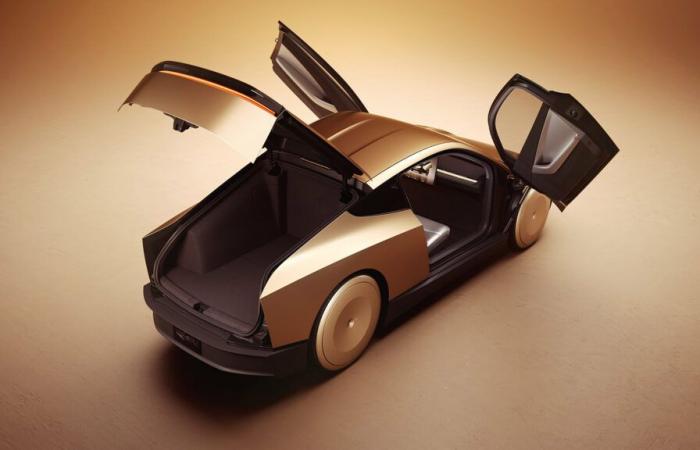
The Tesla Robotaxi project has become a reality in the form of a two-seater electric vehicle with inductive charging, gull-wing doors, and a rumored price of “less than $30,000” before any tax credits when it is released. marketed in 2026.
The Robotaxi will also be available for purchase by everyone, making it the cheapest car announced by Tesla to date, if Elon Musk’s words are ultimately confirmed. While it’s not the proverbial 25,000 Model 2, a sub-$30,000 Robotaxi looks just as promising, aside from the fact that it can only carry two passengers.
Elon Musk kept calling it the Cybercab during his studio presentation in Hollywood, while Tesla officially calls it Robotaxi on its website. The design is Cybertruck-ish as advertised and expected. Elon said they postponed the unveiling because he wanted to introduce some changes to the Robotaxi’s appearance up front, and if those changes included putting a Cybertruck-style light bar on the edge of the hood, they successful.
The Robotaxi doesn’t have pedals or a steering wheel, as Elon said they plan to launch unsupervised DSF next year in Texas and California, and that’s when the first rounds of Robotaxi will take place. The mere fact that Tesla is considering launching a full Level 4 or 5 self-driving feature in such a limited area highlights the challenges ahead before the promised mass adoption of Robotaxi on public roads.
Tesla Robotaxi Wireless Charging
Tesla, however, did not provide details on the Robotaxi’s exact range, battery type, charging speeds or acceleration characteristics. Elon, however, dropped a bombshell by declaring that the Robotaxi will be Tesla’s first car to feature wireless charging.
The concept of inductive charging means that Tesla will not need to equip the Robotaxi with a NACS port, but it also means that there will only be dedicated docks where it can charge, and that speed will likely be much slower than wired charging, just like with phones.
Robotaxi autonettoyant
Since the Robotaxi will be part of a larger ride-sharing Cybercab project that Tesla owners will also be able to participate in with their own Model Y or Model 3 vehicles, Tesla had to find a way to clean it between trips.
She recently patented a UV light and automatic vacuum system for self-cleaning vehicles, and that’s exactly what she showed during the presentation. While the Robotaxi is charging, for example, a robotic arm equipped with a vacuum cleaner enters the cabin, removes all the crumbs, then cleans the large touchscreen in the middle of the dashboard.
It remains to be seen how often the Robotaxi will have to perform these operations, because the patent also refers to a system that detects whether the car is dirty or contaminated based on various sensors and even the weather:
- Environmental detection using various sensors: detection of temperature, humidity, presence of pathogens, etc.
- Custom Sanitation Routines: Generation of appropriate sanitation routines based on detected environmental conditions.
- Various sanitation methods: use of HVAC systems, UV lighting, steam generators, etc.
- Automated processes: automatic execution of sanitation processes in the absence of personnel. Adaptive system: adjustment of sanitation methods based on external weather conditions, vehicle usage history, etc.
Price, tax credit and release date of Tesla’s Robotaxi
Tesla has priced the Robotaxi at a maximum of $29,990, in line with its usual pricing structure. It’s quite possible it could do it for less, given that the Model 3’s production cost is about $28,000 per unit, but that car only has two seats and a screen, with no pedals , no steering wheel, no charging port.
Since it will most likely be powered by Tesla’s own 4680 engine, manufactured using the dry cathode method, the self-driving car will likely qualify for the $7,500 federal tax credit for new vehicles electrical. That would bring the price of the Robotaxi down to $22,490, making Tesla’s proverbial car less than $25,000. As this is a driverless Robotaxi, it should also be equipped with the following FSD 13 or later, for free.
Elon said net operating costs for the Robotaxi, when produced at scale, will be around $0.20/mile, and starting at $0.30/mile gross. He made a comparison to a bus pass and said the average subsidized operating costs there are $1/mile, but it remains to be seen how those calculations will hold up in reality.
Tesla plans to bring the Robotaxi to market in 2026, beginning mass production in two years, around the time it would begin producing its more orthodox steering wheel-equipped sibling – the Model 2 – on the same platform.
Achetez le Tesla Universal Wall Connector EV Charger with Dual Plug sur Amazon





